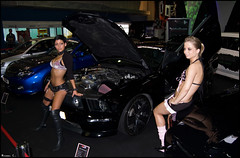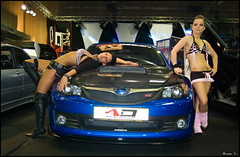
We know what you're thinking. Isn't it a little late to be reviewing the 2010 Shelby GT500? After all, Ford introduced the 2011 version with the new aluminum block at last month's Chicago Auto Show. It's not that we didn't want to get our hands on the 2010 GT500 before now. In fact, we were champing at the bit to review one a few days after our First Drive, but apparently the universe didn't want us to have one until now.
Last summer, a few issues delayed our chance at driving Ford's hottest 'Stang, beginning with Ford running out of tires for the GT500s in the press fleet (we can't imagine why). When Fall rolled around, the transmission in our tester was damaged the week before we were scheduled to take delivery. We were ready to give up hope when the call came in that it would be available in March. Better late than never, right? Besides, who's going to turn down a week with a 540-horsepower muscle car? Al Gore? Definitely not us.
To be honest, our expectations couldn't have been higher. Our last encounter with the 2010 GT500 at Infineon Raceway allowed us to let loose on the 1/4-mile drag strip and smooth pavement of the road course, the perfect playgrounds for a high-horsepower Mustang laden with its infamous solid rear axle. It was essentially on par with the $80,000 GT500KR, but cost $30,000 less and came without Shelby's controversial carbon fiber hood, which we could do without anyway. After a day's worth of fruitful flogging, we were ready to sign the check. But would the GT500 be a less likable character off-track? Could a 540-horsepower Mustang suit our daily requirements of equal parts grocery-getting and canyon-carving?
Visually, the GT500 benefits from the 2010 redesign more so than the standard Mustang V6 and GT models. The rear end, especially the taillights, doesn't look quite as awkward thanks to the subtle spoiler, and the front end takes on a slightly more aggressive appearance with its protruding snout. We're also particularly fond of the new 19-inch wheels, which appear more upscale compared to the previous 18-inch rollers. The plastic front spoiler and rear diffuser come across as bargain-basement pieces, but that might not be such a bad thing. We didn't have any problems making it over some steep dips in the road, but the car arrived with a slightly damaged lip, likely the result of a tall curb in a parking lot. It didn't take long for us to realize that parking the GT500 is more challenging that it would appear, as it's nearly impossible to judge exactly where the massive front end is when pulling forward. If that part of the coupe is going to take some fairly frequent abuse, then we would rather have the parts be as inexpensive as possible.
While the exterior is arguably more attractive than its predecessor, the interior is – without question – vastly improved compared to the previous GT500. Like the Mustang GT and V6, the GT500 benefits from a complete cockpit makeover, with higher quality materials and a more modern look. Soft-touch plastics abound, finally making occupants feel like they might actually be piloting a $50,000 car. And yes, that's real aluminum on the dash. Ford has also added a few thoughtful touches including Alcantara trim on the steering wheel, seats and shifter boot, and we also appreciate the new gauges that somehow look more modern while still retaining a retro look. The matching stripes on the seats and cue ball shifter might be too cheesy for some, but in a car like the GT500, it comes off as cool and clean.



Our test car also came with the Electronics Package that includes the navigation system and dual climate control, a $2,195 option. You'll have to forgive us for not using the SIRIUS Travel Link or the 10-gigs worth of music storage (we already know they're good), but those features weren't our primary focus while we were at the helm. We're sure you understand.
Visuals aside, the GT500 is all about the powertrain. The iron block, supercharged 5.4-liter V8 remains in the car for 2010, although it's rated at 540 horsepower thanks to its open-element air intake and engine management changes. That KR-matching horsepower, plus 510 pound-feet of torque, is channeled through a new twin-disc clutch and six-speed manual with revised gearing. Though Ford has given the GT500 a more aggressive final drive ratio (3.55:1 compared to 3.31:1), both fifth and sixth gear are now taller to provide better fuel mileage on the freeway. That doesn't sound important, but it actually drops the price of the GT500 by $300 thanks to a reduction in the gas guzzler tax. At 65 mph we could doddle along at a mere 1,500 rpm in sixth gear, which contributed to our average of 19.5 mpg overall. Not bad for a 540-hp beast.




Like the engine, the suspension has been improved thanks to knowledge gained through the GT500KR program. The front springs are 13 percent stiffer in front and seven percent stiffer at the rear, and the dampers have been tweaked to provide better control. Steering has also been improved thanks to a softer anti-roll bar and a stiffer steering shaft that reduces input effort.
All of those changes might seem minor, but they add up to a drastically better car than prior model years. While the rush of driving the previous generation GT500 quickly dwindled because of its many deficiencies, there's nothing to impede the driving experience of the new car. The steering is precise, requiring little effort at first and building up feedback as you increase speed. Assuming you haven't overloaded the front tires before going into a corner, the front end goes exactly where you point it despite the mass of iron over the front wheels. The clutch, previously vague and unforgiving, is buttery smooth and just as capable of doing hard launches as it is inching along in traffic. And the shifter, originally one of our biggest complaints in the last GT500, has lost its rubbery feel and provides accurate shifts. It requires a firm grip and a decent amount of effort to row between gears, but we'd almost be disappointed if it were too easy.




We tried to take the GT500 on as many types of roads as possible, and the results were fairly predictable. Long, smooth sweepers suit the car best, providing an easy task for the suspension and allowing the engine to really stretch its legs. The GT500 can even tackle tight turns with surprising agility, swinging the front end around with relative ease. The solid rear axle only lets itself be known over large bumps encountered mid-turn, causing the back end to step out, albeit in a fairly predictable manner that only takes a fraction of a second to correct.
Where the GT500 didn't shine was on the freeways of Southern California. The suspension tuning seemed to harmonize exactly with the repeated bumps in the road, the shocks decompressing exactly as we thudded over the next imperfection in the road. The result of bouncing up and down in our seats in a consistent rhythm over several miles quickly became tiresome.




The GT500's favorite type of road, however, is the one that is very straight, very long and very deserted. These can't be found in abundance near downtown Los Angeles, but we endured a bumpy freeway drive to get out of the city proper, and after all, we needed to test out the new three-stage traction control system. Extensively.
With the traction control fully disabled, which requires holding the TC button for a full eight seconds, the GT500 turns into the world's best burnout machine. Rev the supercharged V8 to practically any RPM, drop the clutch and in a matter of seconds the rear tires will be engulfed in massive clouds of scorched rubber while the engine bangs off redline. Shift to second and the mayhem continues. Only in third gear does the GT500 finally start to gain traction at full throttle, and at that point you'll have already breached the limit of legal speeds. If smoky burnouts are your thing, then feel free to leave the traction control off, but if you're trying to actually go somewhere in a hurry then dial the TC to Sport mode. It allows a small amount of wheel spin before cutting power, and although it still requires a delicate foot to work the throttle, provides a longer leash for tire spin than with the traction control fully on. Once hooked up the GT500 isn't necessarily the fastest car we've driven, but thanks to an insanely flat torque curve it can pull hard from just about any rpm.

But as much as we like the 2010 GT500, it's not a car we would buy. That's not to say we aren't smitten – we're just as in love as we were when we left Infineon Raceway – but we just can't recommend it. It's not the price tag ($46,325 MSRP, $50,895 as-tested), which is an incredible bargain. Nor is it the solid rear axle (negated by Ford's impressive suspension tuning). It's certainly not the interior, or the exterior for that matter.
You see, as good as the 2010 GT500 is, there's something better coming. Just like we would have never bought a 2010 Mustang GT in anticipation of the legendary 5.0-liter V8 arriving in the 2011 model, we would keep our wallet tucked away until the 2011 Shelby GT500 hits showroom floors. With its aluminum block V8 filling the space between the front fenders, the 2011 GT500 should be even better. That's what taking 105 pounds off the front end of a car will do. So be patient, and wait for the 2011 GT500. That's what we're doing.
[Source: Autoblog]































































